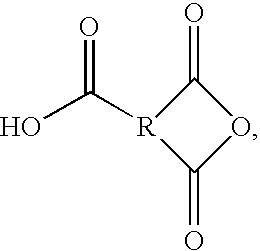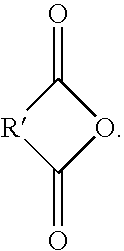Acid functional polyamideimides
a technology of polyamideimide and acid functional, applied in the field of polyamideimide (pai) base coating composition, can solve the problems of economic inability to use amideimide coatings and limit their use, and achieve the effects of reducing the cost of use, and reducing the cost of solvent systems
- Summary
- Abstract
- Description
- Claims
- Application Information
AI Technical Summary
Benefits of technology
Problems solved by technology
Method used
Image
Examples
example 1
[0123] To 160.0 g glacial acetic acid, add 38.4 g (2 equivalents) of trimellitic anhydride and 10.3 g (1 equivalent) of diethylenetriamine. Stir the resulting mixture under a nitrogen blanket and heat the batch to a reflux temperature of 110-120° C. (230-248° F.). Hold for one (1) hour. Cool the batch to room temperature and allow the product to precipitate out of the solution. Filter off the product, wash it with ethanol, and dry the product in an oven. The final product was a tan powder. The material was characterized by NMR and MS to confirm the structure of a bisimide adduct with the secondary amine unreacted.
example 2
[0124] To 160.0 g of glacial acetic acid, add 38.4 g (2 equivalents) of trimellitic anhydride and 13.1 g (1 equivalent) of dipropylenetriamine. Stir the mixture under a nitrogen blanket. Heat the batch to a reflux temperature of 110-120° C. (230-248° F.) and hold for one (1) hour. Cool the batch to room temperature and allow the product to precipitate out of the solution. Filter off the product, wash it with ethanol, and dry the product in an oven. The final product was a white powder. The material was characterized by NMR and MS to confirm the structure of a bisimide adduct with the secondary amine unreacted.
example 3
[0125] To 1000.0 g of glacial acetic acid, add 384.2 g (2 equivalents) of trimellitic anhydride and 297.3 g (1 equivalent) of 4,4′-diaminodiphenylamine sulfate. Stir the mixture under a nitrogen blanket. Heat the batch to a reflux temperature of 110-120° C. (230-248° F.) and hold for three (3) hours. Cool the batch to room temperature and allow the product to precipitate out of the solution. Filter off the product, wash it with methanol, and dry the product in an oven. The final product was a dark blue powder. The material was characterized by NMR and MS to confirm the structure of a bisimide adduct with the secondary amine unreacted.
PUM
| Property | Measurement | Unit |
|---|---|---|
| Equivalent mass | aaaaa | aaaaa |
| Equivalent mass | aaaaa | aaaaa |
| Equivalent mass | aaaaa | aaaaa |
Abstract
Description
Claims
Application Information
 Login to View More
Login to View More - R&D
- Intellectual Property
- Life Sciences
- Materials
- Tech Scout
- Unparalleled Data Quality
- Higher Quality Content
- 60% Fewer Hallucinations
Browse by: Latest US Patents, China's latest patents, Technical Efficacy Thesaurus, Application Domain, Technology Topic, Popular Technical Reports.
© 2025 PatSnap. All rights reserved.Legal|Privacy policy|Modern Slavery Act Transparency Statement|Sitemap|About US| Contact US: help@patsnap.com



